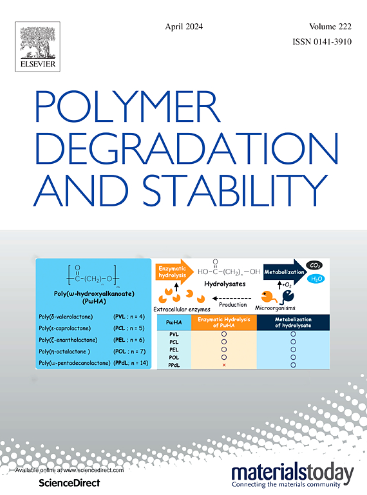Behavior of poly(methyl methacrylate) exposed to extreme ultraviolet laser radiation: A relationship between the high-energy photo-decomposition of the polymer and the mass spectra of emitted ions
IF 6.3
2区 化学
Q1 POLYMER SCIENCE
引用次数: 0
Abstract
This study investigates the fluence-dependent fragmentation of poly(methyl methacrylate) (PMMA) when irradiated with focused extreme ultraviolet (EUV) 26.4-eV photons, using an extreme ultraviolet laser ablation mass spectrometer (EUV LA-MS). Our findings reveal two critical fluence thresholds: the ablation threshold fluence (Fth=9 mJ·cm−2), after which the material begins to desorb and ionize nonthermally, and the transition fluence (Ftr=110 mJ·cm−2), where the interaction shifts to a thermal regime characterized by a nonlinear response in crater formation. The new nonlinear response function recovery (NoReFry) algorithm was used to reconstruct the dose-response curve, using detailed topographical data from atomic force microscopy scans of the ablated craters, enhancing estimation of beam fluence during the experiments. The mass spectra obtained during ablation showed distinct fragmentation pathways that evolve with fluence. Nonthermal conditions primarily produce small fragments, including short-chain ions and gaseous species, while the thermal regime allows for greater fragmentation complexity and the formation of higher molecular weight species. Using experimental data and Monte Carlo simulations, we compared the effects of nano- and femtosecond pulses on the ablation threshold of PMMA. Comprehensive analysis of the mass spectra highlights the dynamics of photoinduced processes, providing insight into the ablation and ionization mechanisms critical for applications in materials processing with EUV radiation.

暴露在极紫外激光辐射下的聚甲基丙烯酸甲酯的行为:聚合物的高能光分解与发射离子的质谱之间的关系
本研究使用极紫外激光烧蚀质谱仪(EUV LA-MS)研究了聚苯甲基丙烯酸甲酯(PMMA)在聚焦极紫外(EUV) 26.4 ev光子照射时的影响依赖性碎片化。我们的发现揭示了两个临界影响阈值:烧蚀阈值(Fth=9 mJ·cm−2),在此之后材料开始非热解吸和电离,以及过渡影响(Ftr=110 mJ·cm−2),其中相互作用转移到以非线性响应为特征的热状态形成陨石坑。采用新的非线性响应函数恢复(norey)算法重建剂量-响应曲线,利用原子力显微镜扫描烧蚀陨石坑的详细地形数据,增强了实验过程中光束通量的估计。在烧蚀过程中获得的质谱显示出不同的破碎路径,这些路径随通量的变化而变化。非热条件主要产生小碎片,包括短链离子和气态物质,而热条件允许更大的碎片复杂性和更高分子量物质的形成。利用实验数据和蒙特卡罗模拟,比较了纳米脉冲和飞秒脉冲对PMMA烧蚀阈值的影响。质谱的综合分析突出了光诱导过程的动力学,为EUV辐射材料加工应用中的消融和电离机制提供了关键的见解。
本文章由计算机程序翻译,如有差异,请以英文原文为准。
求助全文
约1分钟内获得全文
求助全文
来源期刊

Polymer Degradation and Stability
化学-高分子科学
CiteScore
10.10
自引率
10.20%
发文量
325
审稿时长
23 days
期刊介绍:
Polymer Degradation and Stability deals with the degradation reactions and their control which are a major preoccupation of practitioners of the many and diverse aspects of modern polymer technology.
Deteriorative reactions occur during processing, when polymers are subjected to heat, oxygen and mechanical stress, and during the useful life of the materials when oxygen and sunlight are the most important degradative agencies. In more specialised applications, degradation may be induced by high energy radiation, ozone, atmospheric pollutants, mechanical stress, biological action, hydrolysis and many other influences. The mechanisms of these reactions and stabilisation processes must be understood if the technology and application of polymers are to continue to advance. The reporting of investigations of this kind is therefore a major function of this journal.
However there are also new developments in polymer technology in which degradation processes find positive applications. For example, photodegradable plastics are now available, the recycling of polymeric products will become increasingly important, degradation and combustion studies are involved in the definition of the fire hazards which are associated with polymeric materials and the microelectronics industry is vitally dependent upon polymer degradation in the manufacture of its circuitry. Polymer properties may also be improved by processes like curing and grafting, the chemistry of which can be closely related to that which causes physical deterioration in other circumstances.
 求助内容:
求助内容: 应助结果提醒方式:
应助结果提醒方式:


